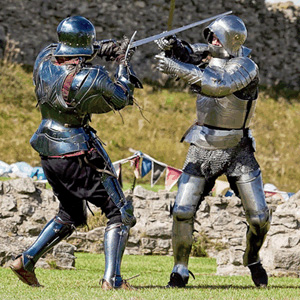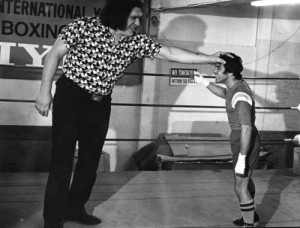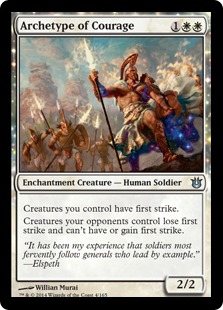The combat phase is perhaps the most important step in limited games. One bad attack or block could completely reverse the board state or lose immediately. Alternatively, failing to attack or block at certain moments during the game could be costly over a long game. In this article, I will discuss common mistakes I see players make and the mindset it takes to overcome those mistakes.
Level of Play
Each opponent is different, and as a result, the attacks and blocks you make should also differ. Against certain opponents it may be correct to attack your 2/2 into their 3/3 without a combat trick, but against other opponents that could cost you the game. It might be useful to divide players into these categories:
Level 0: This player plays with what he has and what he knows. Consider these scenarios:
a) A level 0 player will block his opponent’s 2/2 with his 3/3, not thinking about the possible pump spell.
b) A level 0 player will double block his opponent’s 3/3 with his 2/2s, not fearing the pump or removal spell.
Level 1: This counters level 0 play. Consider the same scenarios from the other side of the table.
a) A level 1 player will attack his 2/2 into his opponent’s 3/3 with a pump spell.
b) A level 1 player will attack his 3/3 into his opponent’s 2/2s with pump or instant speed removal.
Of course, this leaves level 1 play blowing out level 0 play. With this line of attacks, level 1 players will also fail to make these blocks in order to play around their own lines of play:
a) A level 1 player won’t block his opponent’s 2/2 with his 3/3, fearing the pump spell.
b) A level 1 player won’t double block his opponent’s 3/3 with his 2/2s, fearing the pump or removal spell.
Level 2: This is where we start getting into bluffs. Consider the same scenarios from the other side of the table.
a) A level 2 player will attack his 2/2 into a 3/3 without a pump spell if he believes his opponent values the 3/3 more than a pump spell, bluffing an attack.
b) A level 2 player will attack his 3/3 into his opponent’s 2/2s without a pump spell because he doesn’t think his opponent will risk the double block.
Level 2 players will counter level 1 play, allowing them to get in extra damage during certain board positions. Notice, however, that making level 2 plays against a level 0 player is dangerous.
We can continue to describe level 3 players and beyond, but it becomes less useful. At any given point, there’s usually only two options: attack or don’t attack. Level 2 players will make the same attack regardless of whether or not they have a pump spell, so it becomes hard to “counter” that play. You might wonder what the best level of play is, and you won’t find an answer. In order to be a successful magic player, you must be able to adapt and play at any one of these levels. Perhaps that’s what we could define level 3 to be: identifying what level your opponent is playing at and playing exactly one level above him. Next time you bluff an attack and your opponent bites, don’t blame him for making a bad block. You’re the one at fault for not playing exactly one level above him.
Let’s consider some concrete scenarios.
Attacking Into Bigger Creatures
Sometimes it’s necessary to attack into bigger creatures without pump spells, but before you do, consider the following:
a) Are you the aggressor? Keep in mind that your opponent can just choose not to block and attack back with their bigger creature. This might be fine if you’re the aggressive deck, since you aren’t likely to win the late game, but if you’re defensive, missing a few points of damage is unlikely to cost you the game, and it is better not to risk taking an extra 4 from a Minotaur Skullcleaver on the following turn.
b) Is your opponent playing above level 0? Never attack into a level 0 player without a pump spell.
c) Is there a pump spell in your colors that makes the trade favorable for you? Assume your opponent is smart enough to figure out. If you’re attacking with a 2/1 into his 3/3 and you’re not in red (Coordinated Assault) then he’s probably going to block. There isn’t a cheap pump spell (at least not that I know of) in this limited format that saves the 2/1 and takes out the 3/3.
d) Is your opponent’s creature worth more than a pump spell? I’m always willing to trade my Returned Phalanx for a pump spell, but I’m less willing to trade a Thassa’s Emissary.
e) Can your opponent beat a pump spell? This one’s a little tricky to evaluate. Sometimes your board is so overwhelming and your opponent is so behind that he has to block. If he’s losing this game to a pump spell anyways, he’ll play as if you didn’t have one, so you can’t play like you have one.
f) Is losing a creature worth the damage you’re getting in? Let’s say you have 2 2/2s and your opponent has a 3/3 but is at 5 life. Your hand is empty whereas your opponent just got out of his manascrew and has plenty of action. This is probably your last chance to put him at Lightning Strike or Bolt of Keranos range, so you might as well take it.
Free Attacks
A free attack is an attack without risk. Regardless of what level you’re playing at, you should always make the free attack. Consider this scenario: you play a 2/2 and your opponent plays a 1/3. If it’s an Omenspeaker, he’ll probably block, but if he has a Meletis Astronomer, there’s a chance he wants to play a Fate Foretold or something similar for value. The attack isn’t free if you don’t have a follow-up play, of course, since your opponent can just block and then attack back for 1, effectively giving him free damage. But if you don’t care about damage, the attack is pretty much free.
The existence of ordeals is important to consider when an attack is free. If you have another 2/2 in hand, do you risk your opponent playing an ordeal on his 1/3? If you don’t attack then you can threaten to double block.
The Safe Block
Let’s say your opponent attacks with a 2/2 into you 3/3 and you’re tapped out, but you have a Voyage’s End in hand. If you wait until next turn, you can make the safe block and blow him out with Voyage’s End when he decides to pump his creature. The problem with this is having to not attack and hold up mana for the Voyage’s End. If your opponent is good, he will simply skip his attack phase and continue to develop his board. This play works better with a 1/3 or a 1/4, but by holding up Voyage’s End, you still lose tempo advantage if your opponent doesn’t bite. In this situation, it’s important to figure out what level your opponent is playing at.
Getting Blown Out on Defense
One of the easiest ways to lose a game is getting blown out by making bad blocks, especially in this limited format. Dauntless Onslaught and Coordinated Assault make blocking a nightmare in clogged up board positions. If you’re playing against red or white, try to block in such a way that your opponent doesn’t get two for ones with these pump spells. For example, let’s say your opponent is attacking his two 2/2s into your two 2/3s. A level 0 player might simply block each 2/2 with a 2/3, thinking that a single Battlewise Valor would still be a 2 for 1 in his favor. The better play is double blocking a 2/2 with both 2/3s, letting the other 2 damage through. The opponent would then need two pump spells to save his 2/2.
Playing Around Divine Verdict
If you play too quickly like me, you might play into Divine Verdict quite often. If your opponent passes with four mana up and plenty of cards in hand, consider that possibility. Is it fine to lose your creature to Divine Verdict? Probably not if it has any aura attached to it. It’s often better to just continue and develop your board than attack with a voltron. Your opponent can’t hold up mana forever, and you can start to whittle away at him with creatures you’re willing to trade for Divine Verdict.
If your UW opponent passes with 4 mana up, he could also have a counter spell. In this case you have a decision to make. Is your spell in hand more valuable than the creature you could be attacking with? In that case attack before you play your spell to see if he taps out for something. Less valuable? Then play it during main phase one and then only make the attack if he counters it.
Archetypes in BNG
Instant speed removal against the white, blue, and black archetypes in BNG lead to potential blow outs during combat.
When your opponent attacks into your Archetype of Courage and squad of first strikers, chances are he has a removal spell. There’s no best play for every game state in these situations but make sure you consider alternatives before blocking with all of your creatures. Can you swing back for lethal (remember to consider his removal spell)? Can you race him if you just chump? Can you afford to play around the removal spell?
Blocking with Archetype of Finality is a little easier. With Archetype of Finality, you’ll usually be blocking with small, disposable creatures anyways, so it’s fine to get two for oned. Just make sure you don’t throw away all of your creatures if your opponent is attacking with multiple creatures.
Playing around instant speed removal with Archetype of Imagination is trickier. Usually, you will be in a racing situation. Check to see if your opponent’s attacks make sense. Is he holding back creatures that should be attacking? Could you not attack with the Archetype to play around Divine Verdict? Try to risk the fewest amount of creatures possible without changing the clock your opponent is on.
Threatening a Double Block
Let’s say you attack with a 3/3 into your opponent’s 2/2 and then pass the turn. Your opponent plays a 2/3, thinks for a bit, and then decides to pass the turn without attacking with his 2/2. A level 0 opponent making this play is clearly indicating that he plans on double blocking.
If you have a pump spell, the attack is easy. If he double blocks, you trade your pump spell for his two creatures. What if you don’t have a pump spell, though? A level 1 player in your situation probably wouldn’t attack, not wanting to trade his 3/3 for a 2/3.
What if your opponent is playing at level 2, though? By not attacking with the 2/2 he threatens the double block, but that doesn’t mean he plans on making it. When you make the attack, your level 2 opponent will read you for a pump spell and deny the block; he trades two damage (that he missed) for valuable information. If you don’t make the attack, he knows you don’t have a pump spell and he just gained 3 life.
In this case, maybe the best option is to play at level 3 and always make the attack against a competent player. At worst, you trade your 3/3 for a 2/3; at best you deal 3 damage and your opponent puts you on the pump spell that you don’t have.
If you’re on the other side of the table with the 2/2 keep in mind your option of skipping through the attack phase. I’ll commonly see players attacking with creatures that they don’t plan on blocking with, which is usually a good play, but sometimes it can be advantageous to threaten the double block without actually intending to make the block.
Thank you for checking out my article and I hope you guys learned something! I look forward to facing you in combat.
Lenny




